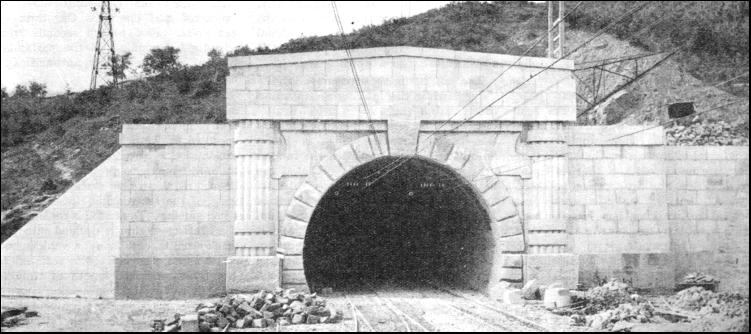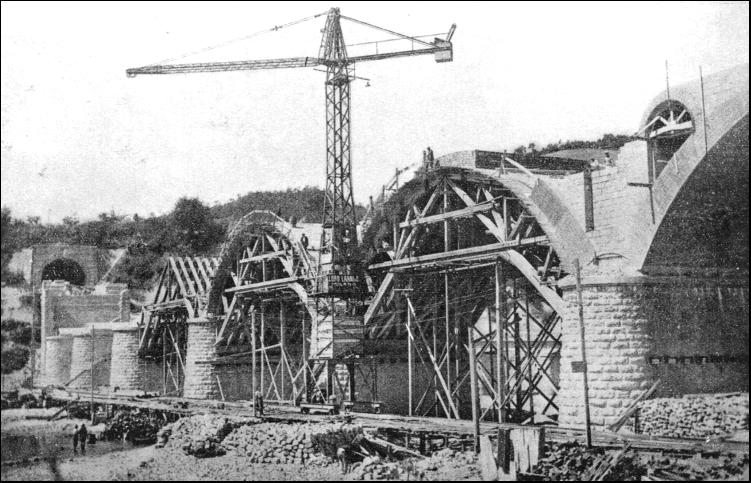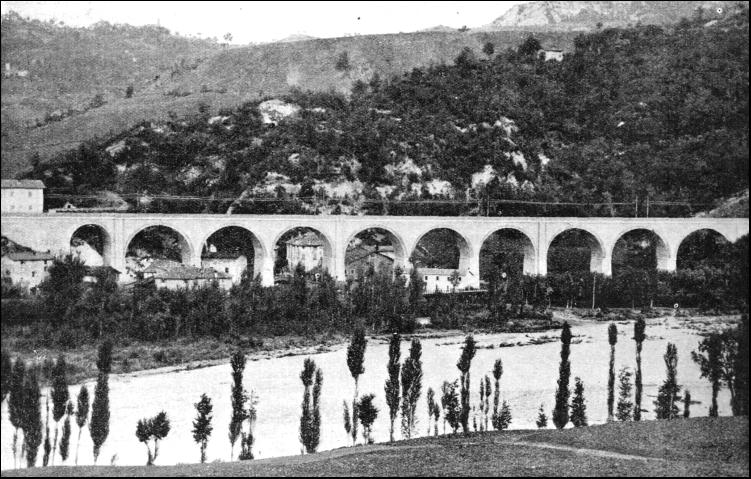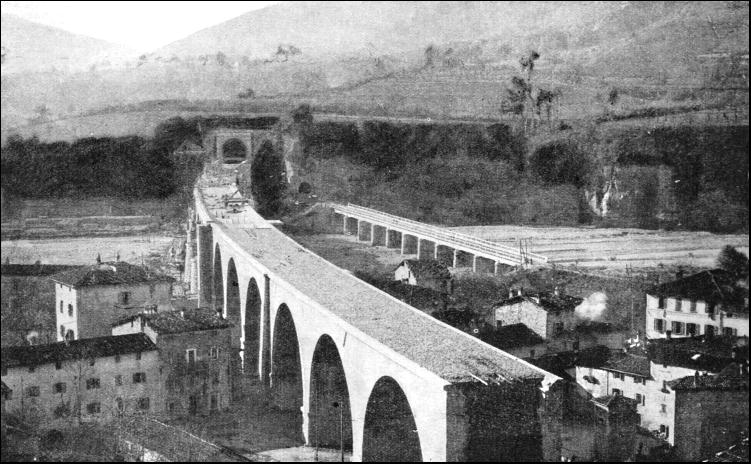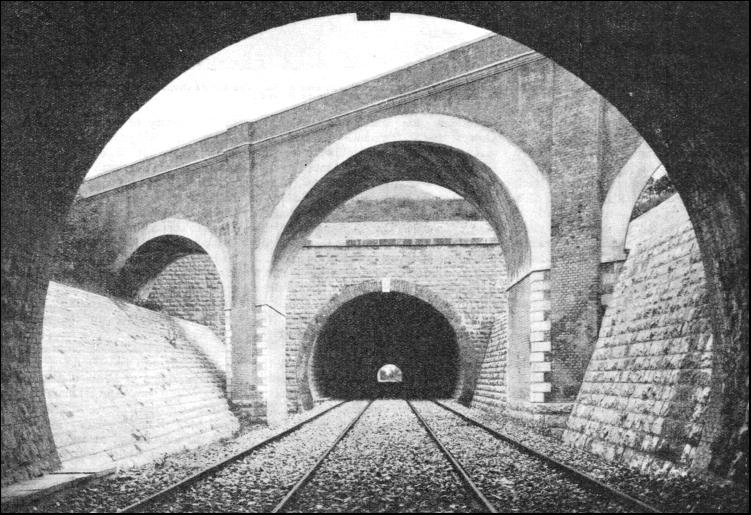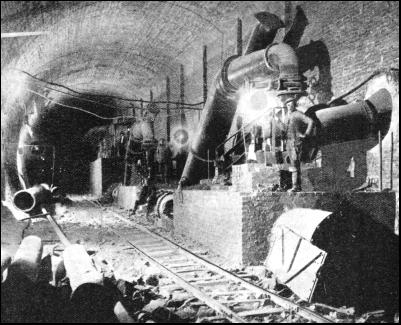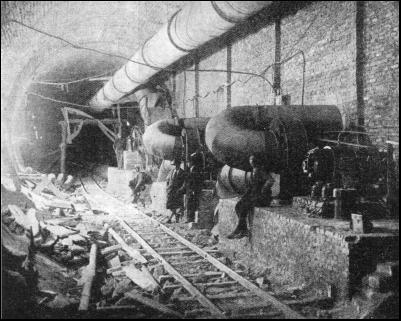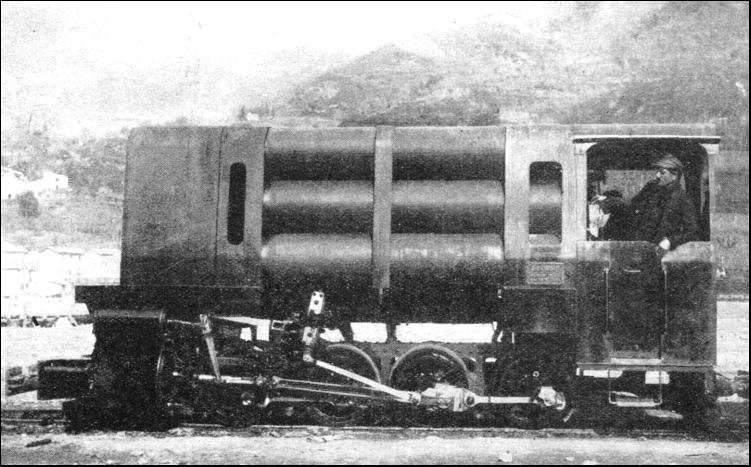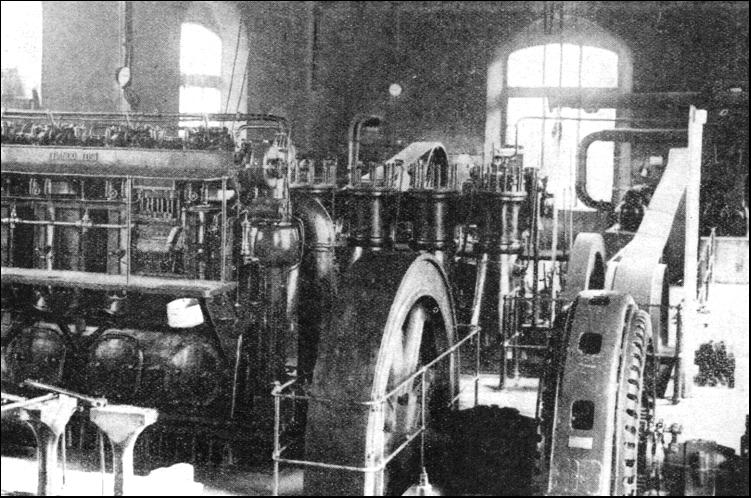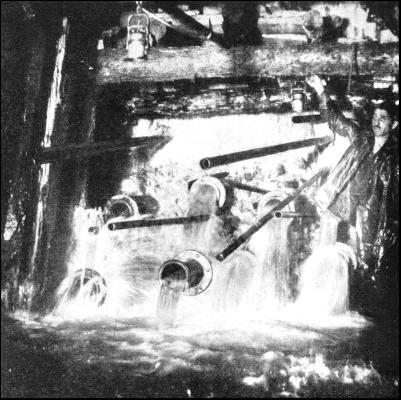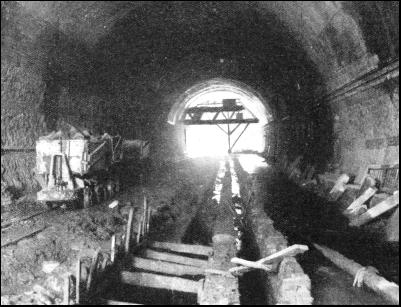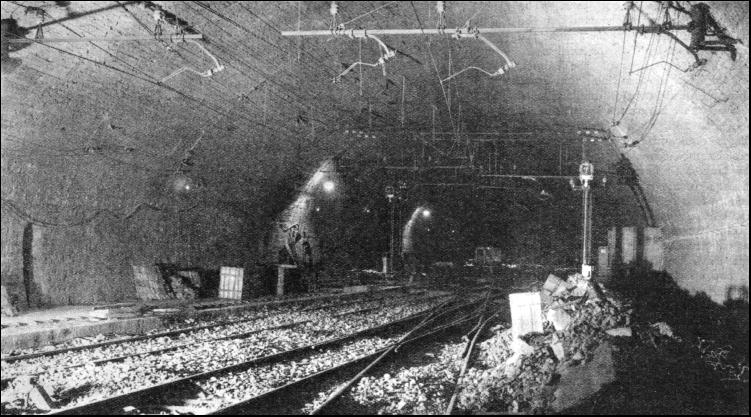|
|
BEFORE entering into the details of the construction of the Great Apennine Tunnel itself, this page will deal briefly with the remarkable line on which it is situated. This railway is known as the Bologna-Florence "Direttissima." The expression "direttissima" has no counterpart in English. It means "the most direct" and, when applied to a railway, indicates a line which has the maximum possible number of straight stretches, curves of very large radius, absence of level crossings and the minimum possible gradients. A "direttissima" is built without fear of natural obstacles through which it has to pass. One is reminded of Tsar Alexander II of Russia, who, on granting the concession for the railway from St. Petersburg (Leningrad) to Moscow, prescribed the route by taking a ruler and drawing a straight line on the map between the two capitals of his empire. The "Direttissima" Bologna-Florence is the second line of this kind which Italy has completed during the last few years. The other "Direttissima" is that from Rome to Naples. Italy's peculiar geographical features have a great influence on the construction and working of her railways. With the exception of the northern parts, the country is a narrow strip averaging about ninety miles in width and extending for 600 miles in length. The Apennine mountain-range traverses it in a longitudinal direction. The construction of railways has accordingly developed mainly along the rugged coast lines ; the trunk line from Bologna via Florence to Rome being the only line of importance which runs in the centre of that narrow strip. It must be remembered that whereas the northern parts of Italy are highly industrialized, the centre and south of the country are mainly agricultural. These latter provide the northern provinces with agricultural and dairy produce, and maintain at the same time a vast export of such products to all European countries. All this traffic moves towards the industrial districts of Lombardy and Piedmont, and across the frontiers at Chiasso, Brenner and Tarvisio, and is carried over a system of lines which include the Florence-Bologna via Pistoia (the Porretta) line and the line via Faenza-Florence and via Sarzana-Parma. All these lines have steep gradients, narrow curves, and the stations possess little accommodation. They were built many years ago when railway engineering was still in its infancy, and when the traffic carried was but a small percentage of what it is to-day. The mountainous character of these lines makes it in many instances almost impossible to double the tracks or to enlarge the stations.
This difficulty of reconstruction applied particularly to the Porretta line from Bologna to Florence via Pistoia. The line was built during the years 1856-62 by the famous railway constructor Protsche, and for many years it was considered to be one of the finest examples of railway engineering in Europe. In those days Italy was still divided into a number of independent territories, kingdoms, and duchies. Florence was the capital of the Grand Duchy of Tuscany. The route of the Porretta line was chosen not only for technical reasons but also for strategical considerations. The length of this line is almost eighty-two miles. Bologna lies at an altitude of 148 ft., and the highest point of the line is reached at the station of Pracchia at an altitude of 2,021 ft. above sea level. The distance from Bologna to Pracchia is forty-six miles. On the southern slope the line descends rapidly towards Pistoia which lies at a distance of fifteen and a half miles from Bologna, at an altitude of 206 ft. The difference in altitude being 1,815 ft., the average gradient is 1 in 45 and reaches on certain stretches, even in tunnels, as much as 1 in 35. Many curves have a radius of less than 330 yards, and the whole line from Pracchia to Pistoia is an almost uninterrupted sequence of tunnels. The time taken between Bologna and Florence was two and three-quarter hours by steam-driven express trains, and even with electric traction it took two and a quarter hours to complete the short journey. Freight trains were limited to 480 tons, so that not more than 180,000 trucks could be handled annually. The inadequate capacity of this line was realized soon after its opening, and when Italy had been united in 1870, the ever-increasing traffic called for better means of communication between the north and the south. Various proposals were suggested for the doubling of the track and the enlargement of the stations, but the consequent expenses would have been so great that they did not warrant the execution of any of these projects, which, generally, offered only a makeshift solution. A commission was appointed to report on various projects submitted for the construction of a new line. In 1908 Parliament approved the construction of the "Direttissima," voting at the same time the necessary credits of £6,000,000 sterling. The project of the "Direttissima" Bologna-Florence line included the construction of a tunnel eleven and a half miles long through the Apennines. This part of the project necessitated long and exhaustive investigations and studies covering a period of two years. During the surveys several alterations in the route were made, and consequently the approach to the entrances of the tunnel had to be changed.
One of the results of the survey was to show that the original estimate of £6,000,000 would not be sufficient. A second provisional estimate for £7,000,000 was made. The provisional project was approved in 1911, and the elaboration of the definite project in all its details was taken in hand. Work on the line began in 1913. This was on the section between Bologna and Pianoro. The new route extended from Bologna to Prato, a station on the old line eight and three-quarter miles from Florence, where the new line joins the Porretta line. The distance between Bologna and Prato is just under fifty-two miles, and the line is laid with a double track. The highest point is at an altitude of 1,058 ft. The maximum gradients in the open are 1 in 85, and in tunnels 1 in 125, with the exception of the Great Tunnel, where gradients are 1 in 500 and 1 in 175. The curves have a radius of 880 yards on the Bologna and of 660 yards on the Florence side. The distance from Bologna to Florence is sixty and a quarter miles, whereas via the Porretta line it is over eighty-one miles. The difference is about twenty-one miles, but the value of the new route, from the working point of view. is enhanced out of all proportion to this reduction of distance, by reason of the considerable lessening of the gradients. The journey from Bologna to Florence now takes sixty-six minutes, while freight trains of 950 tons weight can be hauled over the new line with the same tractive effort as was required for 480 tons over the old line.
The "Direttissima" branches off the Bologna-Ancona line immediately on leaving Bologna. It turns southwards, crosses the river Savena by a masonry bridge of seven arches of 46 ft. span, and continues on the right bank as far as Pianoro. Shortly after this station the line crosses the Savena by a bridge of six arches (five spans of 50 ft. each and one of 20 ft.) and enters the Monte Adone Tunnel, which has a length of 7,694 yards. Having left this tunnel, the line enters the Setta Valley near the station of Vado and, having passed through another tunnel, negotiates the valley by means of an imposing viaduct-bridge of fourteen arches, of which seven are of 65 ft. 7 in. span and seven of 82 ft. span. The line continues on the left bank of the Setta as far as the station of Grizzana. A large number of tunnels and viaducts was necessary on this track. There is a viaduct over the Scopa with twelve arches of 50 ft. span ; another over the Casone with fourteen arches of 40 ft. span, and a third across the Quercia with eleven arches. All these viaducts, as well as the others on the line, are masonry constructions, for which Italians have always been famous. Beyond the station of Grizzana the line crosses the Farnetola Valley by a viaduct of twelve arches, of which eleven are 66 ft. and one of 40 ft. span. Here the Pian di Setta Tunnel begins, which has a length of 3,334 yards. On emerging from the tunnel the Brasinone river is crossed by a viaduct of three arches of 83 ft. span and two of 66 ft., and after a short tunnel the Setta is crossed by a skew bridge with three arches of 66 ft. and three of 40 ft. The line continues on the right bank of the Setta, crosses the river again over an oblique bridge of five arches of 40 ft. span, and enters the Great Apennine Tunnel. From this it emerges near the junction of the rivers Fiumenta and Bisenzio, crossing the latter, and continuing on its left bank as far as the station of Vernio. After having crossed the Bisenzio twice the new line reaches the station of Vaiano and finally joins the old one at Prato.
The double track is laid with rails of 59 ft. 1 in., each length weighing 102.1 lb. per yard, and there are thirty sleepers to every length of rail. The total quantity of ballasting amounted to 655,000 cubic yards. The new line is electrified on the direct current overhead system at 3,000 volts. The contact wires are fed by five transformer stations along the line, where the high-tension current is stepped down to the required voltage. The high-tension current is supplied at 60,000 volts from the hydro-electric power plant which the State Railway Administration has built on the Apennine mountains near Pracchia. For the purpose of storing up the necessary volume of water a vast reservoir has been built by the construction of a dam 300 ft. high, and the plant is one of the finest examples of hydro-electric plants in Europe. The "Direttissima" is also connected with the powerful transformer station of Bologna—San Viola, where high-tension current at 120,000 volts is received from hydro-electric plants in the Alps. It will be appreciated that considerable engineering feats were involved in these subsidiary operations. The Monte Adone Tunnel has a length of 7,694 yards. The track runs straight with the exception of a length of 650 yards, which is on a wide curve with a radius of 2,200 yards. The tunnel was driven from both ends, and as no particular difficulties were encountered it was completed within five and a half years.
The Pian di Setta Tunnel has a length of 3,334 yards. It runs straight for about 1,820 yards, and then on a curve with a wide radius. Difficult conditions of soil were encountered and heavy emanations of methane gas (marsh gas) had to be overcome. Progress was slow, and thirty yards a day was the maximum. Work was begun in 1921 from the northern side, and in 1925 from the south. Advance headings met in 1928. The "Direttissima" joins the old line, as previously mentioned, at Prato. The impossibility of enlarging the existing station necessitated the transfer of the station 700 yards farther south. A magnificent new station building was erected, and a large modem station was laid out. The following figures give an idea of the magnitude of the construction of the "Direttissima," the total cost of which amounted to £12,200,000 sterling. Embankments represent a volume of 192-1/2 million cubic feet; seventy-five and a half million cubic feet of cuttings were excavated , the excavated material from the tunnels amounted to 101-1/4 million cubic feet, the masonry work in the tunnels to sixty-four million cubic feet. The consumption of electric current required for the plants and installations was 101,340,000 kilowatt hours. The line contains forty bridges, the total length of which is two and three-quarter miles ; thirty-one tunnels with a total length of twenty-two and a half miles, thirty-one and a half miles of embankments, and nearly seven miles of cuttings. But the most outstanding feature of the "Direttissima" is the Great Apennine Tunnel, the length of which is 20242.21 yards—eleven and a half miles. Although it is 1,546 yards shorter than the Simplon Tunnel, the longest in the world, the Apennine Tunnel may be considered as the greatest example of tunnel construction in existence, for it is built for a double track, whereas the Simplon has single-track tunnels.
Seldom—if ever—has the construction of a railway tunnel been fraught with so many serious difficulties. All the elements seemed to combine to prevent the completion of the tunnel ; treacherous soil, water in endless quantities, explosions of poisonous gas, and outbreaks of fire—one after the other, often combined. It was a struggle between Titans, on the one hand the elements, on the other—man. And man conquered. A monument erected on the square outside the station of Bologna bears ninety-seven names and the inscription "E TENEBRIS LUCENT." On April 21, 1934, the King of Italy unveiled the monument in commemoration of the opening of the "Direttissima." The ninety-seven names are those of the men who sacrificed their lives on this battlefield of progress. The magnitude of the tunnel construction necessitated a vast amount of preliminary work. The nature of the soil through which the tunnel was to be bored had first to be investigated. Seven shafts were sunk at intervals to below the tunnel line, some of them to a depth of 1,300 ft. By doing this it was possible to ascertain the nature of the ground and its composition. The geological formation of the Apennines differs from that of the Alps. The Alps, where so many famous tunnels have been constructed, are of solid rock, and the boring did not present any particular difficulties. The Apennine mountains on the route of the "Direttissima" consist mostly of clay and sand schists. A worse soil for tunnel construction could not be found. It was clear from these surveys that construction would be very slow if it were undertaken in the usual way from both ends. It was, therefore, decided to create two further points of attack by sinking, about midway at Cà di Landino, two inclined shafts to the level of the tunnel. The two shafts were sunk at a distance of 400 ft. from one another at an inclination of twenty-seven degrees. Their length is 1,683 and 1,605 ft. respectively, and their section is 170 sq. ft. They were connected at the bottom by a wide gallery in which the necessary machinery and pumping installations were erected.
In each of the shafts a cable railway was built for the conveyance of men and the transport of material. The trucks had a seating capacity for thirty men, and the trolleys were built for loads of 2.2 cubic yards. During the later stages of the construction a more powerful driving plant was installed ; this was capable of hauling two trolleys each of 1.9 cubic yards. The hauling machinery was driven by three 75 h.p. motors of 720 revolutions per minute, each of the three pulleys being operated independently by one motor. The hauling ropes had a diameter of 1-3/4 in. The cable railway worked on the "jig-back" system with one ascending and one descending car, which leave the terminals simultaneously and pass each other midway. To allow for this the shafts were widened in the centre. At the sides of the track a staircase was built for emergencies. The shafts were lined partly with bricks and partly with concrete. The construction of the shafts required the excavation of 41,000 cubic yards.
Before the construction of the Great Tunnel could proceed the problem of transporting all the machinery, material and plant had to be solved. Both entrances of the tunnel were a long way from any village, and farther still from any railway station. The existing roads were ordinary country roads, unsuitable for heavy lorry traffic. Furthermore, there existed the possibility of snowstorms or torrential rainfalls rendering the roads impassable. The solution was found in the construction of two service railways. One line of seventeen miles was built from Sasso, a station on the Porretta line, to the northern entrance of the tunnel. The second line of thirteen and a half miles was laid from Prato via the Bisenzio Valley to the southern entrance of the tunnel. The lines had a gauge of 3 ft. 1-3/8 in. The laying of these lines called for a number of constructional works, some of which are of considerable importance. The rolling stock for the service lines consisted of fourteen steam locomotives and 216 trucks, by which two and a half million tons of material were transported. The cost of the two lines, including rolling-stock, amounted to £480,000. The two service lines provided transport facilities only to the two entrances of the tunnel, and in order to bring the entrance to the inclined shafts at Cà di Landino within easy reach, an aerial ropeway was built from the northern tunnel entrance. The length of this ropeway was over five miles, and the difference in level between the two terminal stations 865 ft. The system of the aerial ropeway adopted was that of two carrying and one traction rope. The carriers had a capacity of 8 cwt., and the hourly capacity of the line was twenty-seven and a half tons. The total quantity of material transported by this ropeway was 75,000 tons. The boring of the tunnel started at the north portal in July, 1920, and at the south portal a few months earlier.
At both entrances of the tunnel, and at Cà di Landino, the State Railway Administration built villages to house the thousands of workmen, engineers and their families. The villages were completely equipped ; there were churches, schools, hospitals, maternity homes, kindergarten and cinemas. An aqueduct ensured the supply of fresh water, and electric light was supplied during the first few years by an oil-driven power plant. Later, a line was constructed to convey the current from Prato to Cà di Landino and to the two entrances, where the required voltage was obtained in the transformer stations. The arrangements for the power supply were on a vast scale. Power was generated by eleven Diesel engines varying from 120 to 400 h.p. Their total capacity was 2,540 h.p., of which 600 h.p. were installed at the southern, and 720 h.p. at the northern entrance. There were 1,220 h.p. at the inclined shafts. Electric current was supplied over a 30,000 volts line from Prato, which had a length of twenty-eight and a half miles. Cà di Landino was connected with Bologna by a 30,000 volts line, and during the latter stages of the construction a second line, nineteen miles long, was built from Prato to Cà di Landino to carry 2,000 kilowatts. The transformer stations had a total capacity of 11,270 kilo volt amperes.
In view of the great length of the tunnel careful provisions were made to ensure the supply of fresh air to the farthest working points. The ventilation plants were installed at the two portals and at the two shafts. As the headings proceeded, an auxiliary ventilating plant was installed within the tunnel. Fresh air was supplied at 850 cub. ft. per second. The average daily rate of fresh air driven into the tunnel by the powerful ventilators was fifty-eight million cubic feet from the north entrance, fifty million from the shafts and thirty-five million from the south. On account of such large volumes of air it was necessary to divide the completed and lined sections of the tunnel by a temporary brick bulkhead running longitudinally. Two ducts were formed, the fresh air being driven through one side, the used air escaping through the other. The ventilating plant at either of the portals consisted of two Sulzer fans, each of 850 cub. ft. capacity and driven by 145-170 h.p. motors ; at each of the shafts two Cerpelli fans of 650 cub. ft. each were installed. The auxiliary plant at either heading consisted of a set of fans of 210 cub. ft. driven by 45-55 h.p. motors. These auxiliary fans drew the air from the main ducts and drove it through metal pipes of decreasing diameters to the working faces.
For the transport of men and material inside the tunnel a narrow-gauge railway was laid, over which ran compressed-air locomotives. Two types of locomotives were in use, a smaller one of 40 h.p. for the advance headings and a larger one of 80 h.p. for the completed sections of the tunnel. The air was compressed in the machinery hall and was delivered through steel pipes laid within the tunnel. At certain intervals cocks were fitted in the pipeline from which the locomotives drew their supply. The compressor plant also provided the compressed air required for driving the pneumatic hammers and drills. The presence of gas and the danger of explosions and fire continually worried the engineers in charge. Gas emanations were encountered during almost the whole time of the construction. The gas consisted of ninety-seven per cent of methane which, on account of its low specific weight, rose to the highest points and accumulated behind timbering. Methane is poisonous and, when mixed with air in a given proportion, becomes highly explosive on contact with an open flame or when a detonator is fired. All possible precautionary measures were taken. Specially constructed safety and gas-detecting lamps were employed. These changed colour in accordance with the amount of gas present, and indicated by the length of the flame the proportions of the components in the gas. Trained men were employed to inspect the upper parts of the headings. When gas was found, it was set on fire by distance-controlled fuses. Salvage crews had been trained in anticipation of any serious outbreak, while a permanent supply of water was ensured by the laying of a special pipeline. The water was kept under a high pressure, and along the tunnel a number of pumps were installed and connected with the pipeline. The irruptions of gas were serious at times. Gas issued at the rate of 4-1/2 cub. ft. per second at a high pressure. Fresh air had to be pumped at the rate of 1,350 cub. ft. per second to the danger spots to dilute the gas and render it harmless. The measures proved efficient, and there were only four explosions which caused any serious interruption of work.
Outbreaks of fire were more serious. One, at about three miles from the north portal, stopped work in the affected zone for seven months. This outbreak occurred during blasting, when an onrush of gas occurred and the timbering took fire. Despite all efforts the fire could not be extinguished. On the next day another heavy explosion occurred at the same spot. The ventilation bulkhead was destroyed for over 1,100 ft., as well as the cabin of the ventilation engineer. The upper and lower headings, which intercommunicated, were filled with heavy smoke, for, owing to the collapse of the bulkhead, the whole ventilation system had been damaged. An heroic crew drove up on a compressed air locomotive to the burning timbering. The men flooded the area and checked the fire. Only then was it possible to ascertain that the lower heading had collapsed through the burning of the timbering. The temperature had reached 212 degrees. The temporary bulkhead was rebuilt, and also the ventilating cabin. Meanwhile, in the part of the upper heading where the fire continued unabated, three powerful hydrants protected the scaffolding which was erected to replace the wooden timbering with steel shores. Three fine-mesh wire nettings were put up at a distance of 3-1/2 ft. from one another. But the fire continued furiously for two and a half months. Matters became worse through emanations of gas in the lower heading, they issued from a gas-filled cavern below the tunnel. The whole lower heading became filled with gas and hindered all efforts to extinguish the fire. It was decided to flood the heading to a depth of 14 ft. at the back of a wall which was put up across the heading. In order not to protract the stoppage of work in the northern part of the tunnel, a by-pass tunnel was constructed at 50 ft. distance from the tunnel, over a length of about 700 ft. This by-pass was bored at a short distance in front of the cross wall, and it joined the track of the tunnel beyond the flooded section so that work could proceed. Over 330 ft. were completed beyond the flooded area during this time. Five months after the outbreak the flames had disappeared, and it took another two months to repair the damage.
Fire and gas were not the only obstacles. Water was also a most stubborn enemy ; it was present everywhere, seeping through the roof. through the sides, breaking through from underground caverns, spouting from the drill holes, bursting forth in the form of cascades at the rate of seventy-five gallons per second, and flooding the headings by torrential downpours. The original surveys had revealed that water would be met with in limited quantities, and at first this was so. Three reciprocal pumps had been installed, but with the progress of work more and more water appeared, and the original pumping plant had to be increased until twenty-seven electric pumps with a total capacity of 215 gallons per second were at work. During the period from May 1925 to March 1930, 4,735 million gallons of water (corresponding to an average of 3,366,000 gallons a day) were pumped from the tunnel, a quantity that would be sufficient to fill an artificial lake of 1-1/4 miles in length, 3/4 mile wide and 33 ft. deep. The most violent incursion occurred at a point 6,320 yards from the southern portal, when the waters broke through in the form of a cascade at the rate of 66 gallons per second. The canal built in the centre of the tunnel to collect the waters was insufficient ; the lower heading was flooded and work interrupted. To stop the flow of the water a brick wall, 10 ft. thick, was built and nine steel pipes of 6-3/4 in. diameter were let in to drain off the water. Simultaneously seven pipes of smaller diameter, 15 to 30 ft. long, were driven through the wall, and first a cement mixture and then a mixture of cement, wood and metal scrap was forced through under pressure. But this method, which had previously proved successful at other points, failed this time. The wall was again demolished and where art and science had failed the indomitable will power of the men working waist deep in the floods succeeded. Despite all precautions water continued to trickle through over almost the whole length of the tunnel. In the Apennine Tunnel, where the line is electrified, even a small amount of water upon the overhead contact lines might cause serious trouble, and a dangerous situation would arise if the accumulated water were to freeze and icicles form, To waterproof the crown of the tunnel was a matter of vital importance. This was done over a width of 22 ft. along the whole tunnel. A mixture of cement and sand, under pressure, was injected into a number of holes. The face was then roughened, cleaned with steel brushes, and washed by jets of water under pressure. All joints between bricks or masonry were cleaned of the adhering mortar by pneumatic tools. The waterproofing mixture was then applied in two coats to a thickness of 1 in. To ensure perfect execution, this work was done by hand instead of using cement guns.
The method of driving the tunnel was as follows : First a bottom heading, 13 ft. 1-1/2 in. by 10 ft. 6 in., was driven over a given distance and the narrow gauge railway laid in it. Next, a top heading, 8 ft. 2-3/8 in. by 6 ft. 6-3/4 in., was driven corresponding to the line of the crown. Between these two headings a horizontal division, about 7 ft. thick, remained, which represented the floor of the upper heading. Vertical shafts bored through this division provided communication between upper and lower headings for the purpose of removing excavated material from the upper heading. The spoil was shot through these shafts directly into the trucks in the bottom heading. The top heading was afterwards widened and extended as far down as the springing of the arch. The centring was then set in to keep the arch in position, and the arch excavated to its full dimensions. When the arch was in position the horizontal division between the two headings was removed and the bottom heading excavated to its full dimensions. During this work the arch was supported by timbering. On completion of the side walls the inverted arch was set in. Although the geological survey had made it clear that the soil was of the most difficult kind for tunnel construction, the difficulties which were encountered on certain sections were never expected. The swelling clay soil had given trouble on the northern side, but heavy timbering, sometimes steel centring, the reduction in length of the working sections and the method of completing the lining overcame the difficulties. At a point about one and a half miles from the north portal, however, a serious situation arose. The pressure of the swelling clay was greater than any timbering could withstand. The strongest pieces of 25 in. diameter were shattered to splinters, the strongest steel shoring was bent and gave way. Stronger timbering, steel constructions—combinations of both—were tried. Repeatedly they crumbled beneath the seemingly infinite power. But man conquered again. A new method of tunnel driving, which will no doubt be adopted in future in similar circumstances, was created. The so-called "Italian" method consisted of driving the bottom of a circular section with a diameter of 14 ft. and lining the circumference with rings composed of staunch wooden wedges like keys. The resistance of this cylinder-like structure was powerful enough even in this instance. When deformations occurred in the lining they were easily repaired by driving wedges into the cracks of the lining. Advance headings met in the northern part in November 1929 and in the southern part in December 1929. A feature of the tunnel is the large passing station constructed about mid-way between the bottom of the inclined shafts. Its purpose is to permit fast trains to overtake slow traffic. The station consists of a vast hall which is 505 ft. long and 29-1/2 ft. high ; the diameter of the arch is 56 ft. At either end of this station sidings were built in independent tunnels which join again with the main tunnel. The length of these sidings is 1,470 ft. The section of the tunnel varies according to the nature of the ground. The radius of the crown extends from 14 ft. 6 in. to 14 ft. 9 in., and the height between crown and the inverted arch from 24 ft. 3 in. to 26 ft. Also the thickness of the lining varies. At the crown it is from 1 ft. 9-1/2 in. to 3 ft. 3-1/2 in. and at the inverted arches from 1 ft. 3-3/4 in. to 2 ft. 7-3/4 in. In the passing station the lining of the crown is 4 ft. The magnitude of the tunnel construction may be judged from the following figures : The excavated material amounted to 69 million cubic feet, the masonry work (linings) to 16 million cubic feet. The consumption of electric current was 110 million kilowatt hours, 981 tons of dynamite were used for blasting, an average of 8-1/2 million cubic feet of compressed air was used for traction purposes and for driving the drills and pneumatic hammers ; the average number of men working inside the tunnel was 1,300, and the average number working outside in the yards was 550. The cost of the tunnel was £5,100,000, or £252 per yard.
Many thanks for your help
|
   Share this page on Facebook - Share  [email protected] |

